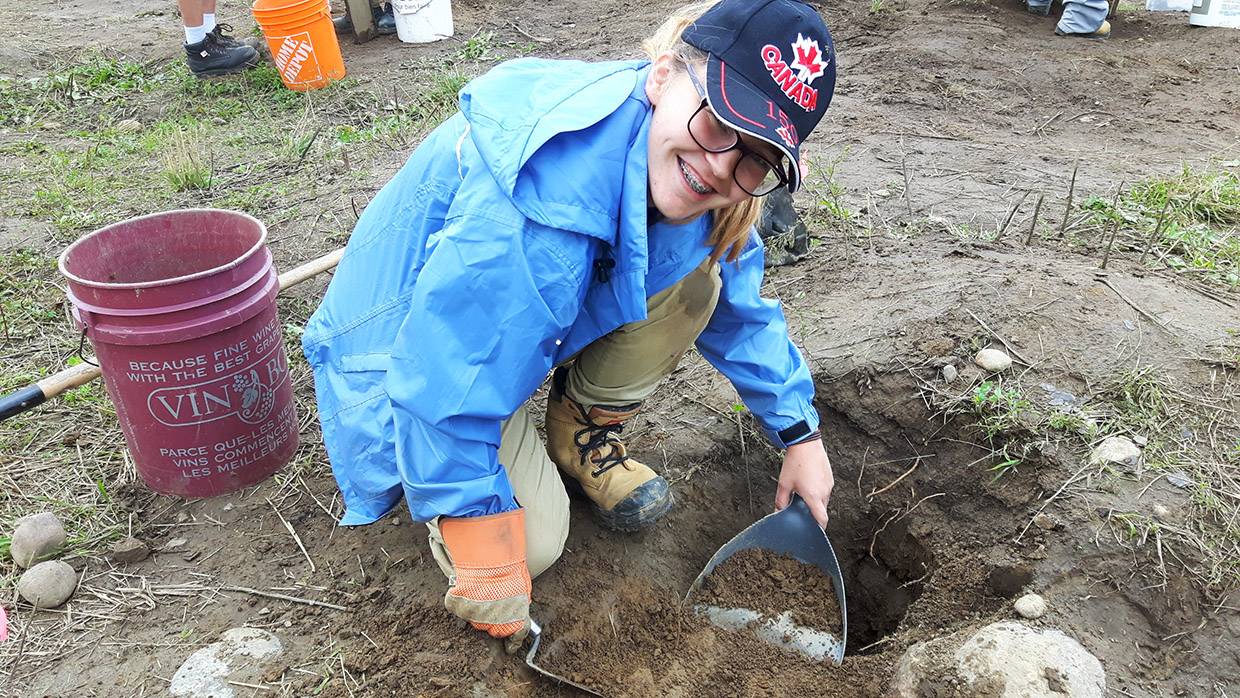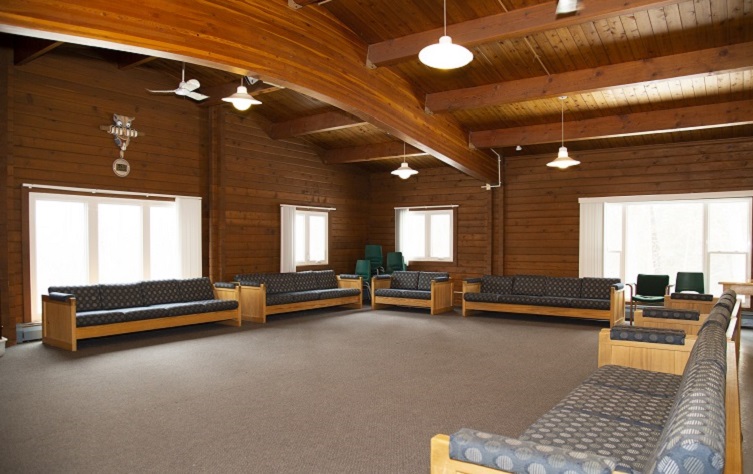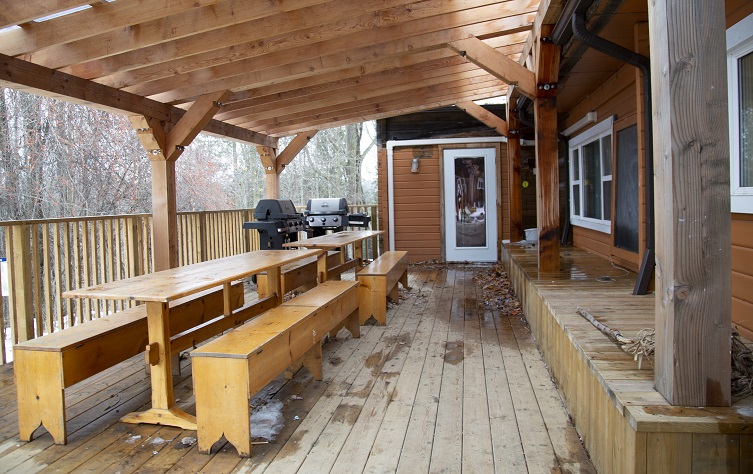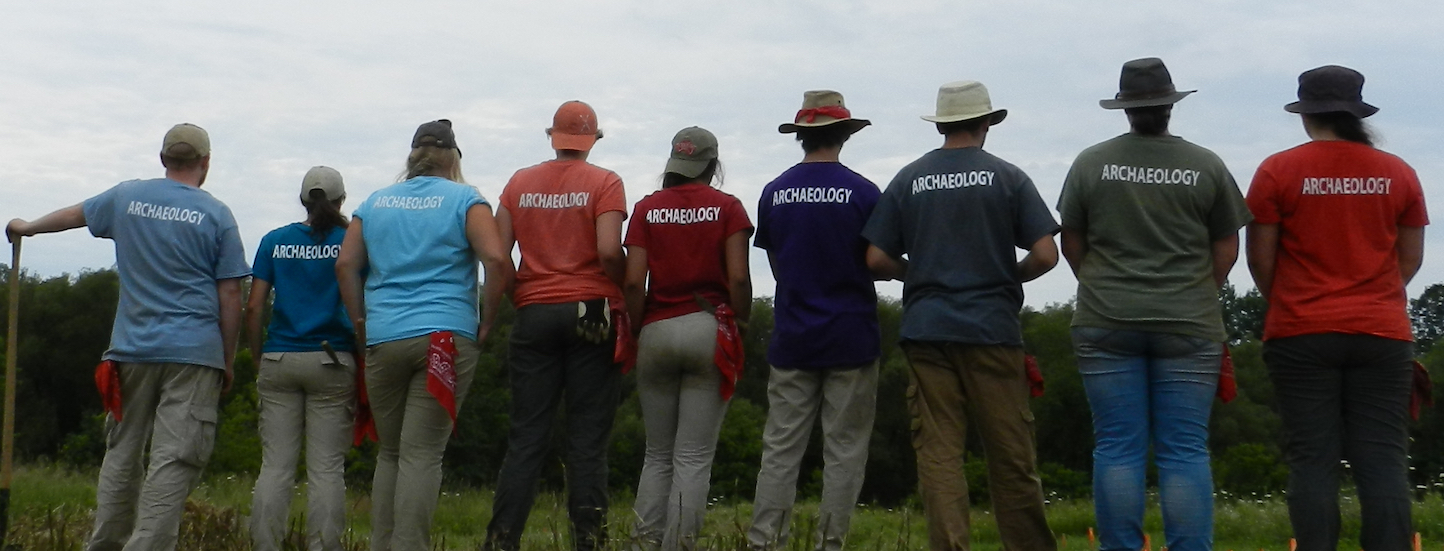Don’t miss out on the experience of a lifetime! Registration for the 2024 Boyd Archaeological Field School closes on Friday, July 5!
2024 Program Dates: August 9 to 25
Our program poster is now available to print and post.
IN COLLABORATION WITH:
Durham District School Board – Continuing Education

Founded in partnership with the Royal Ontario Museum and TRCA in 1975, the Boyd Archaeological Field School (BoydFS) is Canada’s only high school credit course offering students the opportunity to earn Ontario High School Credits while participating in real archaeological fieldwork.
BoydFS has assisted with the documentation of several Ontario archaeological sites, most recently conducting excavations at the Sebastien site, a 700-year old Middle Iroquoian village located in Pickering, Ontario.
“This course has been a life changing experience. I absolutely loved everything … Thanks to all the staff members and the student’s for making this journey so memorable!” — Shamim
Since 1975, more than 1,200 Canadian and international students have experienced local archaeology through the program. Many alumni have gone on to pursue post-secondary studies, advanced degrees and careers in archaeology, anthropology, Indigenous law, and related fields.
QUICK LINKS
About the Course
The Boyd Archaeological Field School takes place at the Claremont Nature Centre. Students gain important background material on archaeology and indigenous history through classroom sessions, and get full on-the-job training in real archaeological skills.
This experiential course challenges students to strive for new levels of achievement in a team environment. Learning experiences include:
- Excavation of a real archaeological site.
- Hands-on activities such as flintknapping and other ancient technologies.
- An academic classroom component featuring sessions led by certified teachers and professional archaeologists, as well as guest lectures from leading experts.
- Career and community connections.

CREDIT:
A combination of field work and classroom studies confers a Grade 12 Interdisciplinary Studies credit (IDC4U/O) and a Grade 11 Co-op credit, DCO3O – Creating Opportunities through Co-op. The course meets credit expectations defined by the Ontario Ministry of Education
PREREQUISITE:
- Completion of Grade 10 at time of course
STAFF:
Course instructors include certified Ontario teachers, licensed archaeologists, Indigenous educators and respected professionals in a variety of specialties.
LOCATION:
Claremont Nature Centre is an outdoor education facility on conservation land in Pickering Ontario. The dorms, classrooms, lounge, and dining hall are all housed in a cedar chalet-style building constructed in 1970. Learn more about Claremont.



COURSE CONTENT:
Field Component
Students will excavate at the Sebastien site in Pickering, 10 minutes by school bus from Claremont Nature Centre. In the 14th century, this site was the location of an ancestral Wendat settlement of unknown size.
“I just wanted to take the time to tell you how thrilled [we] were that Rachel got an opportunity to attend this school. She truly enjoyed it and said even though it was one of the hardest experiences of her life, it was also one of the best! … I do know this program helped make her a stronger, more mature and focused individual.” — David and Asia Belcher
Students, working in pairs, are responsible for the complete scientific excavation of a two-metre square, the recovery of any artifacts within, and the mapping of features that will eventually lead to a complete map of the village.
Students will contribute real archaeological data to our knowledge of this time period in southern Ontario history.
All excavation is supervised by TRCA’s licensed professional archaeologists and their staff of field assistants. Staff also conduct laboratory sessions on artifact identification and other fieldwork-related topics.

Classroom Component
While some content is delivered through lectures and seminars, the non-field portion of our course includes many hands-on, outdoor sessions devoted to activities such as flintknapping and other ancient technologies. In addition to our own teaching staff, leading guest experts offer instruction as well.
Sample topics:
- What is archaeology: an introduction to archaeological theory
- Archaeological excavation
- Analysis and identification of artifacts
- Flintknapping (stone tool-making workshop)
- Origins: First Peoples of the Americas
- The Palaeo period
- Life in the Intense Diversification period (hands-on recreations of ancient technologies)
- Awareness of human interactions with the natural environment
- Iroquoian Society: the Huron-Wendat at the time of contact
- Introduction to modern Indigenous philosophies, worldview and contemporary social issues
COURSE COST:
TUITION:
$2,900.00 + HST (must be a Canadian resident to apply)
Includes the following:
- 17 days of meals and accommodation
- School bus to excavation site
- Teaching staff
- Guest lecturers
- 1:5 staff to student ratio at excavation site
COURSE DATES:
August 9 to 25, 2024



Scholarships & Bursaries
THE SEBASTIEN SCHOLARSHIP:
This scholarship, covering the full tuition for the course ($2,900), is available to any Canadian high school student of First Nations, Métis, or Inuit heritage.
LEARN MORE AND APPLY
PURPOSE:
To cover the full tuition of the Boyd Archaeological Field School (currently $2,900) for a student of First Nations, Métis, or Inuit heritage.
BACKGROUND:
Since 1975, Toronto and Region Conservation (TRCA) has been educating students through Canada’s longest running high school creditable archaeology field course.
Hands-on experiential learning is at the root of this outstanding program, which has attracted students from all over Canada and the U.S., and from as far away as Germany, Italy, Holland, Japan, Israel, and South Africa.
The Sebastien Scholarship offers an opportunity to students of First Nations, Métis, or Inuit heritage and a serious interest in archaeology who might be unable to attend without financial assistance.
ELIGIBILITY AND EVALUATION:
Available to any Canadian high school student of First Nations, Métis, or Inuit heritage, status or self-identified.
Students should have completed Grade 10 and be no older than 21 years at the time of the course.
Applications are to be received in a letter-based format with two letters of reference from a community leader (e.g. elder, council member, teacher, principal, or guidance counsellor) who can attest to your Indigenous heritage or background.
Each letter is to include the student’s mailing address, telephone number, and email address (of the student and a parent).
Students are asked to provide a 500-word essay (written or recorded orally) outlining:
- How they feel archaeology can help them explore their heritage and enrich the traditional histories of their people
- How they might share the knowledge they gain with their community and the broader population of Canada
- What their own aspirations are for future studies and career
For the reference letters, please ask your endorsers to highlight your experience with:
- Traditional culture and activities
- Volunteer and extracurricular activities
- Knowledge-sharing and history
- Your ability to get along with others
While grades are a consideration, the awards will not necessarily go to the student with the highest marks. Rather, we are looking for well-rounded learners who are active in their communities and demonstrate an interest in history and culture.
SUBMISSON OF APPLICATION AND ADMINISTRATION:
We encourage all students to submit their applications (or any questions about the application process) to Alex Payne: alex.payne@trca.ca or (647) 281-6079.
All applications will be reviewed by a committee comprising TRCA Archaeology and Education staff, and potentially members of Durham District School Board’s Continuing Education program, which supports BoydFS.
DEADLINE FOR APPLICATIONS:
The deadline for application is June 1, 2024 at 5:00 p.m.
Applications are to be submitted by email directly to the Field School coordinator: alex.payne@trca.ca.
The successful applicant will be advised prior to July 1, 2024, at which time the award will be granted for enrollment in the 2024 program.
The student attendee will learn further course details, meet the instructors, and visit the Claremont facility at the pre-course session later in July, in person or online.
CONTACT INFORMATION:
We encourage all students with questions about the application process to contact Alex Payne (alex.payne@trca.ca) or Ian Rodhouse (ian.rodhouse@trca.ca).
For more information on the Boyd Archaeological Field School, please visit us at: trca.ca/boydfieldschool.

THE CARR-REID BURSARY:
Providing one bursary in the amount of $1,450 towards the total cost of tuition to help a deserving student attend the Boyd Archaeological Field School.
LEARN MORE AND APPLY
PURPOSE:
To provide one bursary in the amount of $1,450 (half tuition) to assist a deserving student in attending the Boyd Archaeological Field School in 2024. The tuition costs cover all room and board, off-site field trips, and expert guest visits during the two-week course (August 9 to 25, 2024) in northern Pickering, Ontario.
BACKGROUND:
Since 1975, Toronto and Region Conservation (TRCA) has been educating students through Canada’s longest running high school creditable archaeology field course.
This bursary honours individuals who shared a vision for hands-on archaeology education at the high school level in the 1970s and who were committed administrators and teachers of the course for more than 25 years: Terry Carr, first supervisor of Boyd Field Centre, and Ray Reid, the high school history teacher who founded the course.
Their immense contributions to the Field School will always be treasured.
Hands-on experiential learning is at the root of this outstanding program, which has attracted students from all over Canada and the U.S., and from as far away as Germany, Italy, Holland, Japan, Israel, and South Africa.
The Carr-Reid Archaeology Bursary offers an opportunity to students with a serious interest in archaeology who might be unable to attend without financial assistance.
ELIGIBILITY AND EVALUATION:
Applications will be received from high school students in a letter-based format, with a supporting letter of reference from a high school teacher.
Each letter is to include the student’s mailing address, telephone number, and email address (of the student and a parent).
Students are asked to address their financial situation and explain how this bursary would assist them.
Please also describe your career aspirations, your interests, and your goals for the future. We would like to learn more about you and why you would like to attend the Boyd Archaeological Field School.
Evaluation will be assessed on the demonstrated financial need of the student and their passion to attend the Field School.
SUBMISSON OF APPLICATION AND ADMINISTRATION:
We encourage all students to submit their applications (or any questions about the application process) to Alex Payne: alex.payne@trca.ca or (647) 281-6079.
All applications will be reviewed by a committee comprising TRCA Archaeology and Education staff, and potentially members of Durham District School Board’s Continuing Education program, which supports BoydFS.
DEADLINE FOR APPLICATIONS:
The deadline for application is June 1, 2024 at 5:00 p.m.
Applications are to be submitted by email directly to the Field School coordinator: alex.payne@trca.ca.
Successful applicants will be advised prior to July 1, 2024, at which time the award will be granted for enrollment in the 2024 program.
All student attendees will learn further course details, meet the instructors, and visit the Claremont facility at the pre-course session later in July, in person or online.
CONTACT INFORMATION:
We encourage all students with questions about the application process to contact Alex Payne (alex.payne@trca.ca) or Ian Rodhouse (ian.rodhouse@trca.ca).
For more information on the Boyd Archaeological Field School, please visit us at: trca.ca/boydfieldschool.
Frequently Asked Questions
Q: I’m not a student in the Durham District School Board. Can I take the course?
A: Any student who is a Canadian resident qualifies to take the course for credit. Foreign students can take the course, but additional fees apply to receive Ontario High School Credits.
Q: Why is the course so expensive?
A: The cost per day is comparable to similar courses that provide a high school credit, accommodation and meals. It is also comparable to the cost of summer camp for the same length of stay.
It should be noted that the course has a higher than usual staff-to-student ratio, as the site must be properly supervised and excavated to the standards required by archaeological regulations. The benefit to students is that there are always staff on site available for help with homework assignments and study.

Q: Can you accommodate students with special needs?
A: Every year, students with Individual Education Plans (IEPs) take the course. We ask that a copy of the IEP is provided to staff in advance of the course. Students with IEPs benefit from the course’s high staff-to-student ratio.
Claremont Nature Centre was recently renovated to make it more accessible to students with mobility issues. There is an all-terrain wheelchair on site.
Q: Will I need to bring spending money?
A: It’s not essential, but students may wish to purchase the course t-shirt for $20. Also, some of our guest speakers may have books for sale, and our field trip may take us to locations with gift shops.
Q: What special equipment will I need?
A: Green patch work boots (steel toe/sole), plumb bob, tape measure, line level, dustpan. (We’ll go over all of this at the pre-course meeting.)
Q: I really want to take this course, but I already have an IDC4U course and can’t get credit for another one. What are my options?
A: Students who already have an IDC4U credit may have alternative options to record the course. Please email boydfs@trca.ca for further information.

Need More Information?
Contact us at: boydfs@trca.ca





